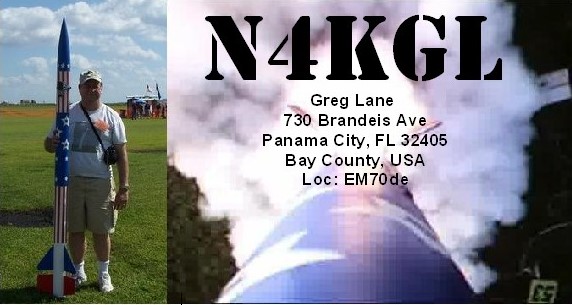I have a start on this idea with the following components
ID-O-Matic II from Ham Gadgets $20
SW-1 20 meter Transmitter from E-Bay $18
14.060 Crystal $12 or possibly cheaper from some sources.
 |
| left ID-O-Matic II , center 20 meter xmtr , and right Par End-fed Dipole match box |
At this point I have assembled the ID-O-Matic II kit and it works like a charm. It is easy to program from my laptop's serial output. I programmed it with RKT RKT RKT DE N4KGL/B N4KGL/B and it will repeat.
I just verified the e ID-O-Matic II does key the transmitter and I am getting three watts out at 13.8 Volts into a dummy load. I tried 9 V and I get 1 watt out.
There are three more challenges power source, antenna and the rocket. Well here are my current ideas:
Power source: The transmitter is nominal 12 Volts. I do not know if it will work on 9V or 18 V. But I believe I can use one 9V plus a couple of AAAs to get the 12V. The transmitter is about 1 to 1.5 watts. My gut feeling is this battery arrangement will handle the requirement for the short duration required.
Antenna: The most interesting challenge. I initially thought about a dipole which is the most basic antenna. Note the total length of a half wave dipole is 468 divided by the frequency in MHz. Therefore the total length for 14.060 MHz would be 33.2 feet. The two legs would be 16.6 feet long and fed in the center insulator. So the rocket would have to deploy the antenna when the motor ejection charge goes off at apogee in vertical fashion with transmitter in the middle and one leg pulled out by the recovery chute The other one leg would be dangling or tied to the shock cord. However, I have a an idea I like better. I have a Par End-fed dipole antenna which has a little matchbox at the transmitter end and can used with a half wave wire The wire will be 33.2 feet long fed from the end. So I could just have a trailing wire attached and drape it out when the rocket is one the pad. (Note: Do not hold the wire). I have some thin lightweight wire that should work. The nice thing is the antenna will be deployed for the entire flight.
Rocket: Many choices and high power could give some great altitudes. However my initial choice is the Fliskit Richter Recker. It is 92 inches long, 2.2 inches in diameter flies on a cluster of 3 24 mm motors, Ds or Es. For this task, I would recover the lower and upper section separately. The upper section would have the beacon payload. The BT-70 tube used in the rocket is very light weight and should hold the components. It should fly to roughly 1000 feet on E motors. I'll need to simulate that when I have the total weight.
 |
| My existing Richter Recker Rocket |
The biggest limitation is the total time the rocket is in the air. My guess right now is 90 seconds. However the QRP guys love a challenge and my idea is to post on QRPSpots just before lift-off. We will see where in the world the beacon will be received.
So I thought I would document this evolving idea and give updates as it comes together. The next launch opportunity will be in January at the SEARS monthly rocket launch in Samson, AL.
Greg
